The Jefferson Barracks National Cemetery
Tour Stop
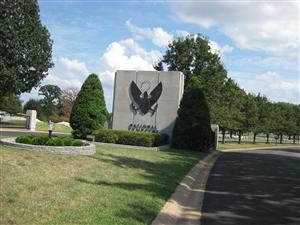
Directions: The entrance to the Jefferson Barracks National Cemetery [ Waypoint = N38 30.097 W90 17.309 ] is located at 2900 Sheridan Road in St. Louis, Missouri 63125.
- Head south on Worth Road.
- After about 0.1 miles, turn right (west) onto Sherman Road.
- Take the first left (south) onto Randolph Road.
- Take the first left (east) onto Kearney Street.
- Take the first right (south) onto Sheridan Road.
- After about 0.3 miles, turn left (east) to enter the cemetery.
- Find a place to park in the Administration Building's parking lot that is located just ahead of the entrance on the right.
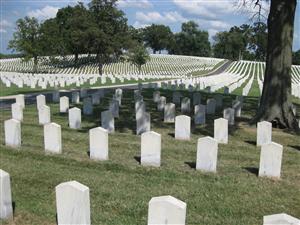
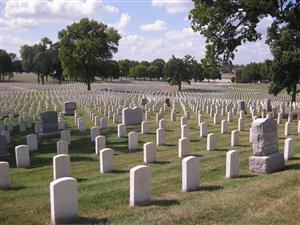
Description: The Jefferson Barracks National Cemetery was established as a national cemetery in 1866, but the first burial occurred shortly after the establishment of Jefferson Barracks in 1826. If you would like to get a cemetery map or located a particular grave, there is a kiosk on the parking lot side of the Jefferson Barracks National Cemetery Administration Building [ Waypoint = N38 30.047 W90 17.293 ].
Constantin Blandowski Memorial at Jefferson Barracks National Cemetery
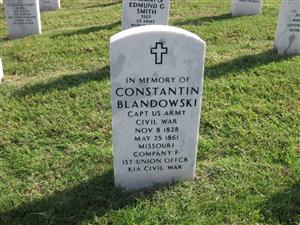
The Constantin Blandowski Memorial at Jefferson Barracks National Cemetery [ Waypoint = N38 29.810 W90 16.998 ] is located at Site 59 in Memorial Section D.
- To locate the Constantin Blandowski Memorial, leave the parking lot and turn right onto Grant Drive.
- Follow Grant Drive about 0.1 miles, taking the second left onto Graves Drive.
- After about 0.2 miles, take the second right onto Lt. Blassie Drive. Section 1R and 1S should be on your right and Section 1T should be on your left.
- Memorial Section D is about 0.11 miles ahead on your right.
- The memorial is on the right. Look on the back of the markers to narrow your search for MD 59
Captain Constantin Blandowski, a Polish-American, was in command of company F in Colonel Franz Sigel's Third Missouri Volunteer Infantry Regiment at Camp Jackson where he received a leg wound. Captain Blandowski would die the next day from the wound making him the first Federal officer killed in the American Civil War. Blandowski is believed to be buried in an unmarked grave (later tour stop) in Gatewood Gardens Cemetery. [137]
Confederate Dead Memorial at Jefferson Barracks National Cemetery
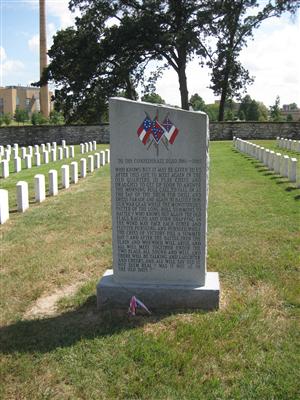
The Confederate Dead Memorial at Jefferson Barracks National Cemetery [ Waypoint = Waypoint = N38 29.870 W90 16.899 ] is located between Sites 68 and 69.
- Turn around and head back the way you came in on Lt. Blassie Drive
- Turn right at the T intersection onto Graves Drive.
- Take the first right onto Longstreet Drive.
- After about 0.1 miles, take the first right onto South Drive.
- South Drive takes a quick left turn and the memorial will be about 50 yards ahead on the right.
The memorial has the following text:
To the Confederate dead 1861-1865
Who knows but it maybe given to us,
after this life, to meet again in the
old quarters, to play chess and
draughts to get up soon to answer
the morning roll call to fall in at
the tap of the drum for drill and
dress parade and again hastily don
our war gear while the monotonous
patter of the long roll summons to
battle? Who knows but again the old
flags, ragged and torn snapping in
the wind, may face each other and
flutter, pursuing and pursued, while
the cries of victory fill a summer
day? And after the battle, then the
slain and wounded will arise, and
all will meet together under the
two flags,all sound and well, and
there will be talking and laughter
and cheers, and all will say: Did it
not seem real? Was it not as in
the old days?
Unknown Dead Memorial at Jefferson Barracks National Cemetery
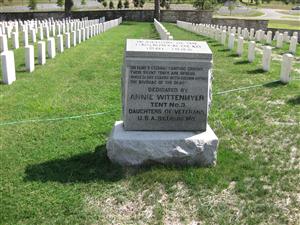
The Unknown Dead Memorial at Jefferson Barracks National Cemetery [ Waypoint = N38 29.871 W90 16.804 ] is located in between Sections 13 and 14.
- It's just about 0.1 miles up South Drive to the memorial.
- The memorial is located on the right.
The memorial has the following text:
In Memory of the Unknown Dead 1861-1865
“On fame's eternal camping ground
Their silent tents are spread;
While glory guards with solemn round
The bivouac of the dead.”
Dedicated by
Annie Wittenmyer
Tent No. 3,
Daughters of Veterans,
U. S. A. St. Louis, Mo.
Women's Memorial at Jefferson Barracks National Cemetery
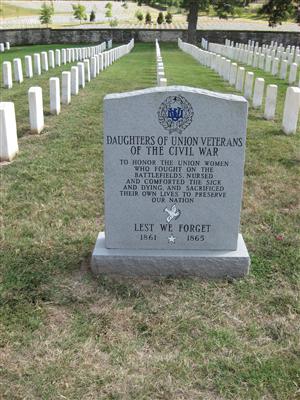
Women's Memorial at Jefferson Barracks National Cemetery [ Waypoint = N38 29.872 W90 16.795 ] is located along the side of the road in Section 13.
- The memorial is less than fifty feet from the Unknown Dead Memorial ahead on the right.
The memorial has the following text:
Daughters of Union Veterans
of the Civil War
to honor the Union women
Who fought on the
battlefields, nursed
and comforted the sick
and dying, and sacrificed
their own lives to preserve
their own lives to preserve
Lest We Forget
1861 - 1865
Union Dead Memorial at Jefferson Barracks National Cemetery
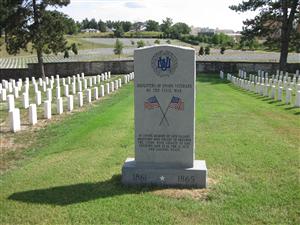
The Union Dead Memorial at Jefferson Barracks National Cemetery [ Waypoint = N38 29.867 W90 16.792 ] is located along the side of the road in between Sections 12 and 13.
- The memorial is less than fifty feet from the Women's Memorial ahead on the right.
- It is set back a little from the road.
The memorial has the following text:
Daughters of Union Veterans
of the Civil War
In loving memory of our valiant
ancestors who fought to preserve
the Union with loyalty to God,
Country, and Flag for a just
and lasting peace.
1861 - 1865
The Minnesota Monument at Jefferson Barracks National Cemetery
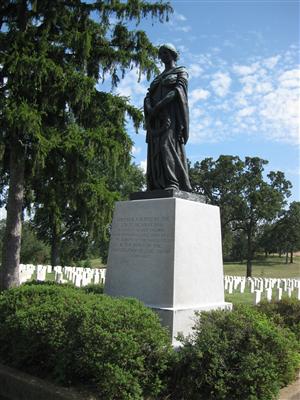
The Minnesota Monument at Jefferson Barracks National Cemetery [ Waypoint = N38 29.903 W90 16.791 ] is located in the center of the intersection of Longstreet and Monument Drives.
- The monument is readily visible to the north of the Union Dead Memorial.
- It is about 150 feet away.
The memorial has the following text:
Erected A. D. 1922 by the
State of Minnesota
in memory of her soldiers
here buried who lost their lives
in the service of the United States
in the war for the
preservation of the Union
A. D. 1861 - 1865
Medal of Honor recipient, Lorenzo D. Immell, at Jefferson Barracks National Cemetery
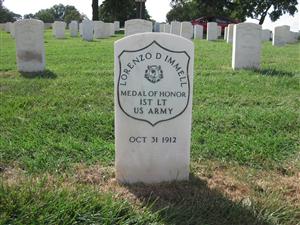
Medal of Honor recipient, Lorenzo D. Immell, at Jefferson Barracks National Cemetery [ Waypoint = N38 29.904 W90 16.721 ] is located in Section 4, Site 12342 in the Old Post Cemetery.
- Return to your car and head east on South Drive.
- At the end of South Drive, turn left on to Old Post West Drive.
- Take the first right onto Old Post South Drive and find a place to park.
- Immell's marker is located north of Old Post South Drive and east of Old Post West Drive.
Immell was awarded the Medal of Honor for his bravery in action during the Battle of Wilson's Creek. The following two soldiers testified about the bravery of Lorenzo D. Immell during the Battle of Wilson's Creek:
William T. Williams: I remember seeing him advance between the enemy and our lines and cut loose the lead team, which had been killed, then mount the saddle horse of the swing team and save the caisson of Corporal Writtenberry's piece, which had been abandoned by all drivers and men, and I remember our whole line cheering him. I also saw him take a mule, put it in place of one of the wheel horses which had been shot, take an axe and cut a small tree, on which the piece was fast, and save the gun; also, saw him advance, under a hot fire, and get a horse belonging to the enemy. . . . Also, remember Capt. Jas. E. Totten's telling him he was the bravest man he ever saw , and that he would be rewarded."
John Kelly: "I was a witness to an act of bravery. . .[Immell] going between the lines at short range and cutting out the dead lead team of Corporal Writtenberry's caisson, and cutting a sapling where it was lodged, and mounting the swing team and taking it out, for which act the line cheered. At close of engagement, his off wheel horse fell fatally wounded, and Corporal [Immell] received three wounds himself. He put a mule in place of the off wheel horse, and saved his six-pounder gun. Otherwise, it would have been abandoned."
Chester Harding, Jr. Grave at Jefferson Barracks National Cemetery
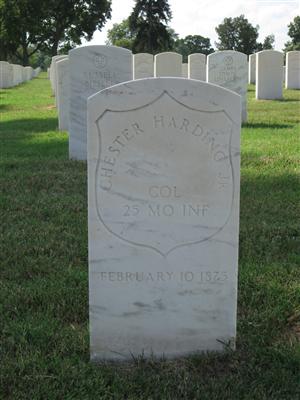
Chester Harding, Jr. Grave at Jefferson Barracks National Cemetery [ Waypoint = N38 29.916 W90 16.701 ] is located in Section OPS1 Site 2288F in the Old Post Cemetery.
- Return to your car and head east on Old Post South Drive.
- Take first left on Old Post East Drive.
- Find a place to park about halfway (about 200 feet) down Old Post East Drive.
- Harding's grave is about 100 feet back from the road.
Born in Massachusetts, Chester Harding, Jr. moved to St. Louis, Missouri in 1847 for the purpose of studying law. After graduating from Harvard College law school in 1850, Harding returned to St. Louis to begin the practice of law. At the start of the American Civil War, Harding would enlist and be commissioned as a Colonel of Federal Volunteers on May 1, 1861. He began his military career as the Assistant Adjutant-General on Brigadier-General Nathaniel Lyon's staff in St. Louis, Missouri. When Lyon left St. Louis to lead the Federal Army of the West in the field, he left Colonel Chester Harding, Jr. in command in St. Louis. Harding was relieved from command in St. Louis when Major-General John C. Fremont assumed command in Missouri. Harding went on to raise an infantry regiment of Federal Volunteers, which fought in the Battle of Belmont. Harding raised another regiment that fought in southeastern Missouri and northern Arkansas. [138]
Nathaniel Lyon made special mention of Harding's service in his first official report to the War Department after being appointed Brigadier-General of Federal Volunteers: [139]
Besides the numerous individuals deserving special notice, I will mention Messrs. Franklin A. Dick, Chester Harding, Jr., Horace A. Conant, Cary Gratz, Samuel Simmons, and B. G. Farrar, who as members of my staff have devoted themselves with joint industry and intelligence to the duties which I have devolved upon them; and in contributing immeasurably to my relief they deserve the thanks and gratitude of myself and our country.
In October of 1864, Colonel Harding, commanding the 43rd Missouri Infantry Volunteer Regiment, was in command of the Federal Garrison at Glasgow, Missouri. During his 1864 raid into Missouri, Confederate Major-General Sterling Price detached a portion of his command to capture Glasgow. On October 15, 1864, a Confederate force of about 1,800 under the command of Brigadier-General John B. Clark, Jr. attacked Harding's force of about 800. Harding described what happened in his official report: [140]
During the morning a flag of truce came to me from the enemy's lines. It was borne by two citizens, who informed me that Brig. Gen. John B. Clark, jr., was in command of the forces in my front and on my flanks, having about 4,000 men; that Brigadier-General Shelby had his division on the opposite side, and that a steam-boat was on its way up to cross the river . . . By noon I had become convinced that I could not hold the place if the enemy chose to make an assault. My line was so thin that it could be pierced anywhere and I could neither shelter nor re-enforce it; while to give up any one position in it was to lose the whole . . . At 1.30 o'clock I surrendered on the terms that the garrison should march out with its arms and colors; officers to retain their horses, side-arms, and private property; the men to retain what private property they had belonging to them; persons and private property of citizens to be respected.
At the beginning of 1865, Colonel Harding was placed in command of the District of Central Missouri's Fourth Sub-District comprising the counties of Jackson, Cass, Bates, and that portion of Vernon County north of the Osage River. His headquarters were located in Kansas City, Missouri. Harding forces would operate in that sub-district against rebel guerrillas still operating in Missouri during 1865. On April 24, 1865, Colonel Harding assumed command of the District of Central Missouri. Towards the end of May, Harding was reporting that many guerrillas were surrendering and taking an oath of allegiance to the United States. Harding received a brevet promotion to Brigadier-General of Volunteers in June of 1865.Harding relinquished command of the District of Central Missouri on June 25, 1865. [141]
The 56th U.S. Colored Infantry Memorial
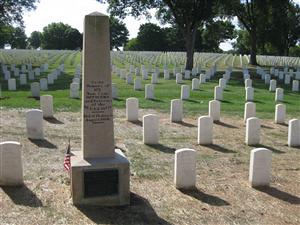
The 56th U.S. Colored Infantry Memorial [ Waypoint = N38 29.969 W90 16.943 ] is located in Section B of the cemetery.
- Return to your car and head north on Old Post East Drive.
- Turn left (west) onto Old Post Drive North.
- After about 0.1 miles, turn left (south) onto Monument Drive at the T intersection.
- Take the first right (west) onto First Drive South.
- After about 0.15 miles, turn right (north) onto Bundy Drive at the T intersection.
- After driving about 100 yards, find a place to park.
- The memorial is an obelisk on the right (east) side of the road.
In 1939, the remains of 175 officers and soldiers of the 56th U.S. Colored Infantry Regiment were re-interred here at the Jefferson Barracks National Cemetery. The memorial was dedicated on May 19, 1939.
The 56th U.S. Colored Infantry Regiment was originally designated the Third Arkansas Infantry (African Descent). It was the first colored regiment mustered into service in the State of Missouri. The regiment was mustered into service in St. Louis on August 12, 1863. Re-designated the 56th U.S. Colored Infantry Regiment on March 11, 1864. The regiment primarily served garrison duty in Helena, Arkansas during the war. In August of 1866, the regiment lost 2 officers and 647 enlisted men to cholera. The regiment was mustered out of service on September 15, 1866. [142]
